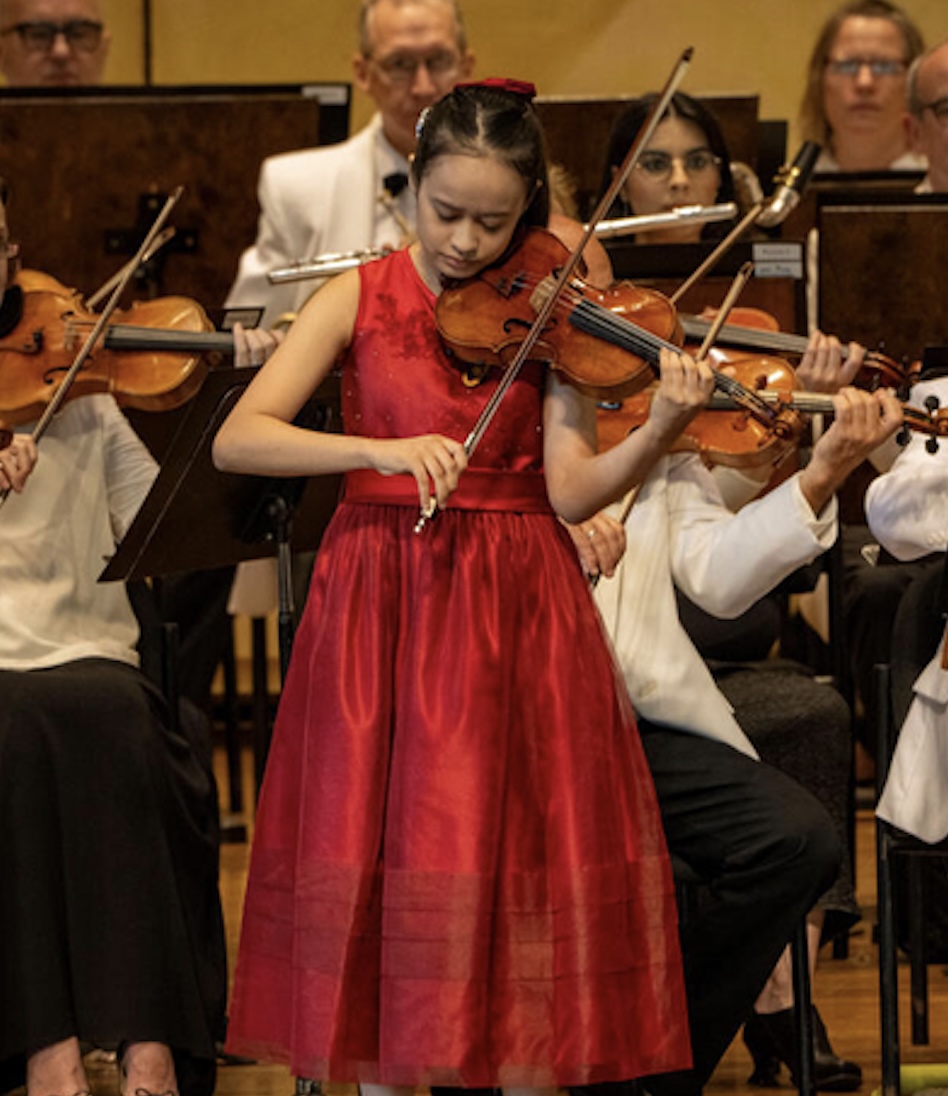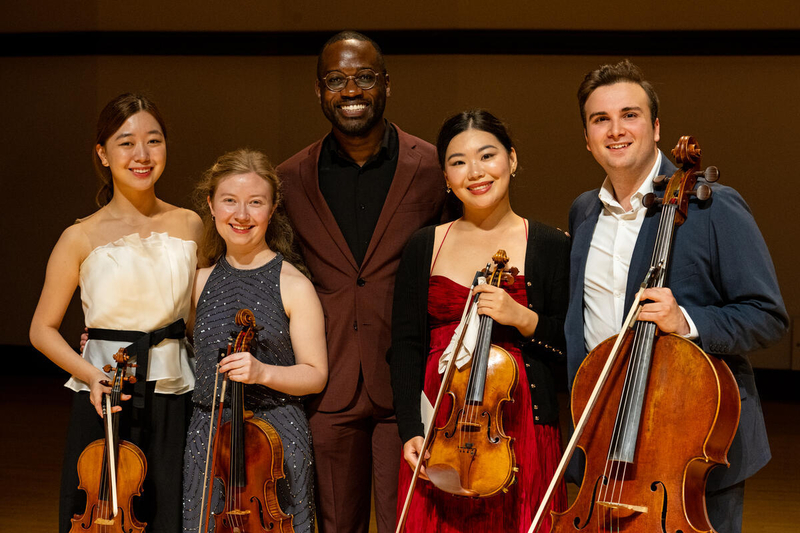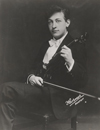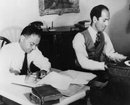Reviews
One Prodigy, Two Premieres at Ravinia Festival
 HIGHLAND PARK, Ill.—On July 20, Ravinia Festival, the summer home of the Chicago Symphony Orchestra, gave listeners that all-too-rare opportunity: the chance to hear two brand-new works in one day.
HIGHLAND PARK, Ill.—On July 20, Ravinia Festival, the summer home of the Chicago Symphony Orchestra, gave listeners that all-too-rare opportunity: the chance to hear two brand-new works in one day.
You would have had to nose around a bit to know that. The festival threw most of its advertising zhuzh behind Himari Yoshimura, the buzzy, barely-14 violin phenom appearing with the CSO and conductor Marin Alsop that evening. Already billed simply as “Himari,” the Curtis student has been hailed as a once-in-a-generation talent. It’s the kind of marketing cud that makes journalists roll their eyes and parents—the rightly protective ones, at least—furrow their brow.
How much of young Himari’s career is driven by her, versus those around her, is not wholly clear at this early stage. What was clear, during Sunday’s performance, is that those superlatives are well-deserved.
Nor is it on the basis of technique alone, though goodness knows she has plenty of that. Her first rocket-ship ascent in Franz Waxman’s Carmen Fantasie (of Humoresque fame) was as powerful as it was faultlessly precise. Harmonics were clear and glassy as the CSO flutes returned her calls in the “Seguidilla.” In the riotous final riff on Carmen’s “Chanson bohème,” she scaled the fingerboard with lyrical, pristine octaves.
Himari never once betrayed the sweat-inducing difficulty of it all, her expression placid throughout. Despite the poker face, however, she proved she has the same rare gift as her predecessors Hilary Hahn and Midori: emotional, not just technical, precocity. For all the combustible virtuoso writing in both the Fantasie and Fritz Kreisler’s La gitana, which she also played, Himari’s sound has an essential soulfulness. She doesn’t shy away from portamento and digs into the violin’s chesty middle register. Indeed, La gitana found its footing once she’d gotten the declarative E-string statement out of the way and started singing freely as a mezzo.
That said, bigger-picture interpretive maturity was tough to discern in this performance. You don’t reach for La gitana if you’re looking for profundity. Plus, occasional sprints ahead of the CSO indicated the young virtuoso is still learning how to be a simpatico solo partner. It was no coincidence that she was at her most rhapsodic in her encore, Ysaÿe’s Sonata No. 6, where she was able to fully sit in the driver’s seat. (Just as delightful: the astonished grins and mouthed “wows” in the CSO violin section, watching her play.)
Himari’s 2025/26 season digs into more concerto repertoire—like the Bruch, on which she has widely concertized and which she brings to the CSO’s subscription season in February. It’s still a piece of youthful fervor, no doubt. But it is likely one that will offer a fuller glimpse of this meteoric talent.
Two strong premieres, alike in urgency
One wonders what Midori thought of Himari, exploding onto the musical scene in much the same way she did 40 years ago. As the new director of Ravinia’s Steans Music Institute, its young artist program, the violinist herself was present the day of Himari’s CSO debut to support the Steans fellows’ recital earlier that afternoon.
That program included the premiere of Joel Thompson’s First String Quartet, a Ravinia commission. Not every composer writes one of the defining works of the 21st century, much less before his 30th birthday, as Thompson did in his 2015 choral work Seven Last Words of the Unarmed. In his quartet, this inventive young composer demonstrates the same knack for reframing established forms without coming across as self-consciously novel. In his program note, Thompson explained that he thinks of the quartet as a “manual” for hardship, whether that’s “battling disease,” “rising up against fascism,” or “exist[ing]… in an imperialist heteronormative white supremacist capitalist patriarchy.”
 Joel Thompson with Steans fellows who gave an insightful, generous premiere
Joel Thompson with Steans fellows who gave an insightful, generous premiere
The first movement, titled “scream,” does as it promises, with collective wails and slides into the instruments’ highest registers. Wafting legatos in the second movement, “cry,” drift downwards, like descending tears. This movement also encloses tender duet passages, between second violin and cello and again between second violin and viola.
Amid the quartet’s intensity, “plant” is an unapologetically joyous interlude. A sunny theme is underpinned by a juicy plucked glissando in the cello. It’s genial and earthy all the way through its final moment: a simultaneous, smiling pizzicato that drew delighted giggles during Sunday’s performance. The quartet ends with “fight,” which, in another clear connection to its title, features pugnacious, au talon wallops in the cello.
Just when it seemed that each movement was an island from the preceding, Thompson ingeniously reintroduced a melody only briefly heard, then stamped out, in the “scream” movement. In “fight,” the melody was finally able to grow and develop, like a wild hope sown generations earlier. Thompson’s is an unequivocally brilliant addition to the string quartet repertoire—and it received an insightful, generous premiere performance by talented Steans fellows Boha Moon and Muyan Yang (violins), Jakob Giovanni Taylor (cello) and Miranda Werner (viola).
Ravinia’s other commission, Malek Jandali’s Rhapsody for Orchestra, preceded Himari’s CSO appearance. Alsop championed Jandali’s music at her former post with the ORF Radio-Symphonieorchester Wien; her affinity for the Syrian–American composer’s musical language—embedding Middle Eastern maqams (melodic and scale patterns) in the instrumental context of the Western symphony orchestra—showed in this often rousing performance.
Much like Thompson’s quartet movements, Jandali’s piece lives up to its title. The 12-minute work is more impressionistic than narrative, instead offering a Bólero-esque timbral exploration of two Syrian maqams. Instrumental doublings reign, often creating the feel of a massed incantation.
Somewhat contradicting Jandali’s platitudinous program note, Rhapsody doesn’t end peacefully: Strings take up a pounding unison line that brings the work to a tense conclusion. But it—and Thompson’s quartet, too—felt like an honest mirror of our world. That alone was its own small catharsis.
Photo of Himari courtesy of Ravinia Festival





 FEATURED JOBS
FEATURED JOBS

 RENT A PHOTO
RENT A PHOTO


